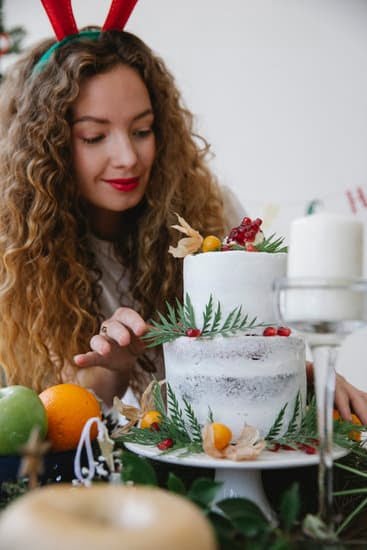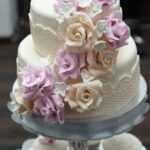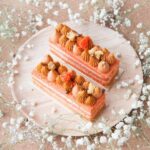Cake decorating is a captivating art form that plays a crucial role in enhancing the visual appeal of any cake creation. The ability to transform a simple cake into an edible masterpiece is both awe-inspiring and rewarding. In this article, we will delve into the world of cake decoration, exploring its importance and providing you with a perfect cake decorating dough recipe that will bring your creations to life.
Cake decoration not only adds a touch of beauty to cakes but also has the power to evoke emotions and create lasting memories. From elegant wedding cakes to whimsical birthday creations, the artistry involved in cake decorating knows no bounds. Whether you are a professional baker or an enthusiastic home baker, mastering the techniques of cake decoration can elevate your baking game to new heights.
Now, let’s introduce you to the perfect cake decorating dough recipe that will serve as the foundation for all your artistic endeavors. This versatile dough offers smooth texture and pliability, making it ideal for creating intricate designs and sculptural elements on your cakes. With this dough at your disposal, you can unlock limitless creative possibilities and bring your imagination to life on every slice of cake.
Join us as we embark on a journey through the enchanting world of cake decorating. From essential ingredients and equipment to step-by-step guides and troubleshooting tips, this article will equip you with everything you need to master the art of transforming cakes into works of art. Get ready to unleash your artistic side and create delicious masterpieces that are sure to impress any audience.
Essential Ingredients and Equipment for Cake Decorating
Essential Ingredients
When it comes to cake decorating, having the right ingredients is crucial for achieving the perfect dough. Here are the essential ingredients you’ll need:
- All-Purpose Flour: This forms the main component of the cake decorating dough. Opt for a high-quality all-purpose flour to ensure a good texture and taste.
- Butter: Use unsalted butter as it provides a creamy texture and enhances the flavor of the dough. Make sure it is softened at room temperature before use.
- Powdered Sugar: Powdered sugar adds sweetness and helps to bind the dough. Sift it before adding to prevent lumps.
- Egg Whites: Adding egg whites helps to improve the elasticity and structure of the dough. Separate them carefully from the yolks and whisk until frothy.
- Vanilla Extract: A few drops of vanilla extract will give your cake decorating dough a delightful aroma and flavor. Choose pure vanilla extract for best results.
- Salt: Just a pinch of salt helps to balance out the sweetness in the dough, enhancing its overall taste.
Must-Have Tools and Equipment
To achieve professional results in your cake decoration, you’ll need some essential tools and equipment. Here’s what you should have on hand:
- Mixing Bowls: Having different sizes of mixing bowls allows you to prepare various amounts of dough and makes it easier to mix ingredients evenly.
Baking Scale or Measuring Cups: Accurate measurements are crucial in baking, so invest in a kitchen scale or measuring cups for precise amounts of ingredients.- Electric Mixer: While it is possible to mix the dough by hand, an electric mixer will save you time and effort. It helps to achieve a smooth consistency and thoroughly incorporates all the ingredients.
- Piping Bags and Tips: Piping bags are essential for creating intricate designs on the cake. Invest in a variety of tips to achieve different patterns and textures.
- Spatula: A spatula is useful for scraping down the sides of the bowl and ensuring all ingredients are incorporated properly.
- Rolling Pin: If you plan to create decorative elements using fondant or gum paste, a rolling pin is necessary for rolling out these materials to your desired thickness.
Tips for Selecting High-Quality Ingredients and Tools
To ensure the best quality outcome, here are some tips on selecting high-quality ingredients and tools:
- Choose organic or natural ingredients whenever possible to enhance the taste and overall quality of your cake decorating dough.
- Read product reviews or seek recommendations from experienced bakers regarding specific brands of flour, butter, extract, and other ingredients. Quality can vary among different brands.
- Invest in well-known and trusted brands when purchasing equipment like electric mixers or piping bags to avoid any issues during the decoration process.
- Check for durability and ease of use when selecting tools such as measuring cups, spatulas, or piping tips. Poor-quality tools can affect your overall experience and results.
By following these guidelines on essential ingredients and equipment selection, you’ll be well-equipped with everything you need to create stunning cake decorations with your dough recipe.
Step-by-Step Guide to Making the Perfect Cake Decorating Dough
Making the perfect cake decorating dough requires attention to detail and a precise process. Follow this step-by-step guide for foolproof results every time:
- Measure Ingredients: Start by gathering all the ingredients needed for the dough. This typically includes flour, sugar, butter, eggs, vanilla extract, and any additional flavorings or additives. Use a reliable kitchen scale or measuring cups to ensure accurate measurements.
- Mix Dry Ingredients: In a large mixing bowl, combine the flour and any other dry ingredients specified in the recipe, such as baking powder or salt. Use a whisk or fork to thoroughly mix the dry ingredients together, ensuring they are evenly distributed.
- Cream Butter and Sugar: In a separate bowl, cream together the butter and sugar until light and fluffy. This can be done using an electric mixer on medium speed or by hand with a sturdy whisk. The creaming process helps incorporate air into the mixture for a softer texture.
- Add Wet Ingredients: Gradually add in the eggs one at a time, mixing well after each addition. Then, stir in the vanilla extract or any other desired flavorings. Ensure that all wet ingredients are fully incorporated before proceeding.
- Combine Dry and Wet Mixtures: Slowly pour the dry ingredients into the bowl with the wet mixture while continuously mixing on low speed (if using electric mixer) or by hand with a spatula. Mix just until all of the dry ingredients are moistened; avoid overmixing to prevent tough dough.
- Knead Dough: Transfer the dough onto a clean work surface lightly dusted with flour. Using your hands, gently knead the dough for about 2-3 minutes until it becomes smooth and pliable. If the dough is too sticky, add small amounts of flour as needed; conversely, if it is too dry, add small amounts of liquid like milk or water.
- Chill Dough (Optional): Depending on the specific recipe, it may be necessary to chill the dough in the refrigerator for a specified amount of time. This step helps enhance the dough’s flavor and makes it easier to roll out and shape later.
Once you have mastered this step-by-step guide, you will have a perfect base of cake decorating dough ready to transform into beautifully decorated cakes. Remember to practice and experiment with different techniques and flavors to truly unleash your creativity.
Exploring Variations and Flavor Enhancements for Cake Decorating Dough
Adding Flavors to Cake Decorating Dough
One of the exciting aspects of cake decorating is the ability to experiment with different flavors and create unique combinations. By adding flavor enhancements to your cake decorating dough, you can elevate the taste and wow your guests with every bite. Here are some suggestions for incorporating delicious flavors into your dough:
- Citrus Zest: To add a refreshing twist to your cake, consider including citrus zest in your dough. Lemon, lime, or orange zest can bring a bright and tangy flavor that complements various cake flavors. Make sure to finely grate the zest and mix it into the dough thoroughly for even distribution.
- Chocolate Delight: If you’re a chocolate lover, why not infuse your cake decorating dough with rich cocoa powder? This will give your creations a delectable chocolate flavor that pairs well with different types of cakes. Be sure to use high-quality cocoa powder for the best results.
- Aromatic Spices: To add warmth and depth of flavor, consider incorporating aromatic spices into your dough recipe. Cinnamon, nutmeg, ginger, or even cardamom can lend a unique taste to your cakes. Remember that these spices can be quite potent, so start with small amounts and adjust according to personal preference.
Customizing Dough for Occasions
Another way to enhance your cake decorating is by customizing the dough according to specific occasions or themes. This allows you to create truly memorable cakes that reflect the overall mood or purpose of the event. Here are some tips for customizing the dough:
- Colorful Creations: Use food coloring gel or liquid dye to tint the dough in vibrant hues that match the occasion’s color scheme or theme. For example, pastel colors work well for Easter-themed cakes, while bold shades like red and green are perfect for Christmas designs.
- Flavored extracts: Apart from enhancing the taste, flavored extracts can also contribute to the overall theme of your cake. For example, using almond extract in the dough can add a subtle nutty taste that complements wedding cakes or special occasion desserts.
- Seasonal Inspirations: Consider incorporating seasonal ingredients into your dough to create cakes that are perfect for specific times of the year. For example, during fall, you can add pumpkin puree and spices like cinnamon and cloves to create a deliciously spiced cake.
With these variations and customizations, you can transform your cake decorating dough into an exciting canvas for flavor experimentation and creative expression. Don’t be afraid to think outside the box and try new combinations that will make your cakes truly unforgettable.
Mastering Various Decorating Techniques with Cake Decorating Dough
Skillfully Piping Intricate Designs
One of the key techniques in cake decorating is piping intricate designs using the cake decorating dough. Piping involves using a piping bag fitted with various nozzles to create different shapes and patterns on the cake’s surface. To master this technique, start by preparing the dough to the ideal consistency – smooth and pliable but not overly sticky. Fill a piping bag with the dough, choosing a nozzle that matches your desired design.
To pipe intricate designs, it is important to have steady hands and good control over the pressure applied to the piping bag. Practice on a flat surface before moving onto the actual cake. Start by applying gentle pressure to the piping bag while moving it in a continuous motion. This will help create clean lines and prevent any breaks or unevenness in the design.
Creating Stunning 3D Sculptures and Decorative Elements
Cake decorating dough can also be used to create stunning 3D sculptures and decorative elements for cakes. With some patience and creativity, you can bring your cakes to life with beautiful flowers, figurines, or any other desired shapes.
Start by sculpting a small amount of dough into the desired shape using your hands or specialized tools like silicone molds or sculpting tools. The dough should be pliable enough to mold easily but firm enough to hold its shape. Once you’ve created your sculpture or decorative element, place it on the cake using edible glue or royal icing as an adhesive.
Remember to take time with each detail and pay attention to proportions and symmetry for an impressive final result. With practice, you’ll be able to create intricate sculptures that will amaze everyone who sees them.
Exploring Advanced Techniques: Marbling, Stenciling, and Embossing
In addition to piping and sculpting techniques, there are several other advanced techniques you can explore with cake decorating dough. Marbling, stenciling, and embossing are just a few examples of these techniques that can add depth and texture to your cake designs.
To achieve a marbled effect, mix different colors of dough together, rolling and folding them until the desired marbled pattern is achieved. This can create a beautiful and unique look on the surface of your cakes. Stenciling involves using specially designed stencils to create intricate patterns or images on the cake’s surface. Simply place the stencil over the cake and spread a thin layer of dough over it. Carefully remove the stencil to reveal the design.
Embossing is another technique that involves pressing molds or textured surfaces onto rolled-out dough. This creates raised patterns or designs on the dough that can then be used as decorative elements on the cake.
By exploring these advanced techniques, you can take your cake decorating skills to new heights and create truly exceptional designs. Remember to experiment with different techniques and have fun with your creations.
Troubleshooting Common Challenges in Cake Decorating Dough
When it comes to cake decorating, even the most skilled bakers can face challenges with their dough. However, with some insight and expert advice, these hurdles can be easily overcome. In this section, we will explore common challenges that may arise when working with cake decorating dough and provide solutions to help you achieve flawless results.
One common issue that bakers encounter is dough cracking. This can happen when the dough becomes too dry or is overworked. To prevent cracking, it is important to ensure that the dough has enough moisture by using the recommended amount of liquid ingredients in the recipe. If the dough still cracks after baking, a simple solution is to brush the cracked areas with a syrup or glaze to help seal them.
Another challenge that bakers might face is dough stiffness or stickiness. Stiff dough can be difficult to work with and may result in uneven decorations. On the other hand, sticky dough can cause decorations to lose their shape or stick to surfaces.
To address stiffness, try kneading the dough for a longer period of time or adding small amounts of liquid until it reaches a more pliable consistency. For sticky dough, dusting your hands and work surface with flour can help prevent sticking.
| Challenge | Solution |
|---|---|
| Dough Cracking | – Use recommended amount of liquid ingredients
|
| Dough Stiffness/Stickiness | – Knead longer or add small amounts of liquid for stiffness
|
By following these troubleshooting tips, you can overcome common challenges in cake decorating dough and ensure that your creations turn out beautifully. Remember, practice makes perfect, so don’t be discouraged if you encounter difficulties along the way. With perseverance and the right techniques, you’ll be able to create stunning cakes that are sure to impress.
Showcasing Cake Decorating Dough in Action
Cake decorating dough is not just a means to an end; it is the vehicle that brings your creative vision to life. In this section, we will explore some inspiring designs that have been crafted using the featured cake decorating dough recipe. These designs showcase the versatility and endless possibilities that this dough offers in terms of creating visually stunning cakes for any occasion.
One popular design trend that has emerged in recent years is the use of vibrant colors and bold patterns. With cake decorating dough, you can create eye-catching geometric designs, abstract patterns, or even marbled effects that are reminiscent of watercolor paintings. By manipulating the dough and combining different colors, you can achieve truly unique results that will impress your guests.
Another way to elevate your cake designs is by incorporating 3D sculptures and decorative elements made from cake decorating dough. From delicate flowers and intricate lace patterns to fondant figurines and edible architectural structures, these sculptural elements add depth and dimension to your creations. With patience and practice, you can master the art of molding the dough into any shape or form you desire.
Furthermore, cake decorating dough allows you to experiment with advanced techniques such as stenciling and embossing. Stenciling involves placing a stencil over the cake and applying colored icing or edible dust through it to create intricate designs. Embossing involves making impressions on the surface of the dough using textured mats or molds.
| Design | Description |
|---|---|
 | A modern cake design featuring a geometric pattern created by layering different colors of icing. |
 | An elegant tiered cake adorned with a lifelike sculpted flower made from cake decorating dough. |
 | A vintage-inspired cake featuring a filigree design achieved through stenciling with edible dust. |
These examples illustrate just a fraction of what you can achieve with cake decorating dough. The possibilities are truly endless, limited only by your imagination and willingness to experiment. So go ahead, let your creativity take center stage and create cakes that are not only delicious but also works of art.
Bonus Tips and Tricks for Elevating Your Cake Decorating Game
Cake decorating is not only an art form but also a way to enhance the visual appeal of your creations. In this section, we will provide you with bonus tips and tricks to take your cake decorating game to the next level. These expert-advised hacks will help you add professional finishing touches and creative ideas that will make your cakes stand out and impress any audience.
One tip to elevate your cake decorating game is to use glazes and edible paint. Adding a glaze can give your cake a beautiful glossy finish and enhance the flavors. You can create a simple glaze by combining powdered sugar, milk, and flavor extracts like vanilla or lemon juice.
Once your cake is cooled, pour the glaze over it, allowing it to drip down the sides for a stunning effect. Edible paint is another fun technique that allows you to add intricate designs or patterns to your cakes using food coloring mixed with alcohol or clear extract. With edible paint, you can create beautiful watercolor effects, intricate details, or even write personalized messages on your cakes.
Another way to elevate your cake decorating game is by experimenting with different textures and techniques. For example, try using textured mats or stencils to imprint patterns onto fondant or buttercream icing. You can also use various piping tips to create unique textures on cupcakes or larger cakes. Mixing different textures creates visual interest and adds depth to your design.
Finally, don’t be afraid to think outside the box when it comes to decorations. Consider incorporating other edible elements such as fresh flowers, fruits, or chocolates into your designs. Edible flowers not only add an elegant touch but can also infuse additional flavors into your cakes. Using unique shapes or molds for chocolates can bring a touch of whimsy and surprise factor to your creations.
By utilizing these bonus tips and tricks for elevating your cake decorating game, you will be able to create masterpieces that amaze and delight others. Remember, practice is key, so don’t hesitate to experiment and refine your skills. With creativity and dedication, you can take your cake decorating to new heights and become a true artist in this captivating world of cake decoration.
Conclusion
In conclusion, cake decorating is a truly captivating art form that allows individuals to express their creativity and enhance the visual appeal of their creations. The cake decoration dough recipe provided in this article is the perfect tool to bring your artistic visions to life. By following the step-by-step guide provided, using high-quality ingredients and tools, and exploring various flavor variations and techniques, you can create stunning cakes that are sure to impress.
It is important to remember that cake decorating is a skill that requires practice and experimentation. As you continue to work with the cake decorating dough recipe, it is encouraged to unleash your artistic side and try new designs, flavors, and techniques. Don’t be afraid to push boundaries and elevate your skills.
One of the joys of cake decorating is the ability to share your creations with others. Whether it’s through social media or special occasions, showcasing your masterpieces can inspire others and bring joy to those who admire your work. This article invites readers to share their own success stories and tips as they journey through their own cake decorating adventures.
Frequently Asked Questions
What is homemade fondant made of?
Homemade fondant is typically made using a few simple ingredients, including marshmallows, powdered sugar, water, and some form of fat like vegetable shortening. The process involves melting the marshmallows with a bit of water until they become smooth and gooey.
Then, the melted marshmallow mixture is gradually mixed with powdered sugar until a thick dough-like consistency is achieved. Finally, the fondant is kneaded well and can be tinted with food coloring if desired.
How do you make wood grain effect on a cake?
Creating a wood grain effect on a cake can be achieved using different techniques. One common method involves coloring some fondant in various shades of brown to represent different wood tones. Then, small pieces of these colored fondants are rolled into thin ropes or snakes and laid side by side on the cake surface.
Using a toothpick, you can gently drag horizontal lines across the fondant ropes to simulate the grain pattern found in wood. Additionally, you can lightly brush edible dust or cocoa powder over specific areas to enhance the depth and texture of the wood grain effect.
Does marshmallow fondant harden?
Marshmallow fondant does have the ability to harden over time but not as much as traditional fondant made with gelatin. While it may develop a slightly firmer outer layer when left exposed to air for some time, marshmallow fondant tends to remain softer and more pliable compared to other types of fondants.
However, this can be advantageous when working with it since it allows for easier shaping and molding without cracking or drying out quickly. If you desire a harder finish on your marshmallow fondant decorations or want them to set firmly on your cake, you can apply a light coat of cornstarch or powdered sugar before allowing them to dry completely.

Welcome to our cake decorating blog! My name is Destiny Flores, and I am the proud owner of a cake decorating business named Cake Karma. Our mission is to provide delicious, beautiful cakes for all occasions. We specialize in creating custom cakes that are tailored specifically to each customer’s individual needs and tastes.





